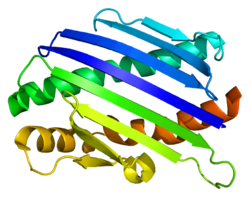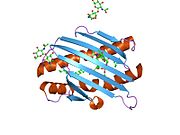Endothelial protein C receptor
| PROCR | |||||||||||||||||||||||||
|---|---|---|---|---|---|---|---|---|---|---|---|---|---|---|---|---|---|---|---|---|---|---|---|---|---|
 | |||||||||||||||||||||||||
| |||||||||||||||||||||||||
| Identifiers | |||||||||||||||||||||||||
| Aliases | PROCR, CCCA, CCD41, EPCR, protein C receptor | ||||||||||||||||||||||||
| External IDs | OMIM: 600646 MGI: 104596 HomoloGene: 4670 GeneCards: PROCR | ||||||||||||||||||||||||
| |||||||||||||||||||||||||
| |||||||||||||||||||||||||
| |||||||||||||||||||||||||
| |||||||||||||||||||||||||
| Orthologs | |||||||||||||||||||||||||
| Species | Human | Mouse | |||||||||||||||||||||||
| Entrez | |||||||||||||||||||||||||
| Ensembl | |||||||||||||||||||||||||
| UniProt | |||||||||||||||||||||||||
| RefSeq (mRNA) | |||||||||||||||||||||||||
| RefSeq (protein) | |||||||||||||||||||||||||
| Location (UCSC) | Chr 20: 35.17 – 35.22 Mb | Chr 2: 155.75 – 155.76 Mb | |||||||||||||||||||||||
| PubMed search | [3] | [4] | |||||||||||||||||||||||
| Wikidata | |||||||||||||||||||||||||
| |||||||||||||||||||||||||
Endothelial protein C receptor (EPCR) also known as activated protein C receptor (APC receptor) is a protein that in humans is encoded by the PROCR gene.[5][6][7] PROCR has also recently been designated CD201 (cluster of differentiation 201).
The protein encoded by this gene is a receptor for protein C that enhances its activation. Protein C is an anti-coagulant serine protease activated by the blood coagulation pathway.
Structure[]
EPCR protein is an N-glycosylated type I membrane protein that enhances the activation of protein C.[7] It belongs to the MHC class I/CD1 family of proteins, that is characterized by having a deep groove, that in other proteins in the family (but not in EPCR) is usually used for antigen binding.
Like the CD1 series, EPCR has a lipid in the corresponding groove. The bound lipid in EPCR is usually phosphatidylcholine, but it may be phosphatidylethanolamine, and it contributes to protein C binding, though probably not through direct contact [8]
Clinical significance[]
Mutations in this gene have been associated with venous thromboembolism and myocardial infarction, as well as with late fetal loss during pregnancy.[7]
The protein is also involved in Plasmodium falciparum malaria as subtypes of the Plasmodium falciparum erythrocyte membrane protein 1 (PfEMP1) family use EPCR of the host as a receptor.[9]
References[]
- ^ a b c GRCh38: Ensembl release 89: ENSG00000101000 - Ensembl, May 2017
- ^ a b c GRCm38: Ensembl release 89: ENSMUSG00000027611 - Ensembl, May 2017
- ^ "Human PubMed Reference:". National Center for Biotechnology Information, U.S. National Library of Medicine.
- ^ "Mouse PubMed Reference:". National Center for Biotechnology Information, U.S. National Library of Medicine.
- ^ Fukudome K, Esmon CT (Nov 1994). "Identification, cloning, and regulation of a novel endothelial cell protein C/activated protein C receptor". J Biol Chem. 269 (42): 26486–91. doi:10.1016/S0021-9258(18)47220-1. PMID 7929370.
- ^ Rothbarth K, Dabaghian AR, Stammer H, Werner D (Oct 1999). "One single mRNA encodes the centrosomal protein CCD41 and the endothelial cell protein C receptor (EPCR)". FEBS Lett. 458 (1): 77–80. doi:10.1016/S0014-5793(99)01074-1. PMID 10518938. S2CID 25425851.
- ^ a b c "Entrez Gene: PROCR protein C receptor, endothelial (EPCR)".
- ^ Esmon CT (May 2004). "Structure and functions of the endothelial cell protein C receptor". Critical Care Medicine. 32 (5 Suppl): S298-301. doi:10.1097/01.CCM.0000126128.64614.81. PMID 15118534.
- ^ Turner L, Lavstsen T, Berger SS, Wang CW, Petersen JE, Avril M, Brazier AJ, Freeth J, Jespersen JS, Nielsen MA, Magistrado P, Lusingu J, Smith JD, Higgins MK, Theander TG (2013). "Severe malaria is associated with parasite binding to endothelial protein C receptor". Nature. 498 (7455): 502–5. Bibcode:2013Natur.498..502T. doi:10.1038/nature12216. PMC 3870021. PMID 23739325.
Further reading[]
- Esmon CT (2004). "Coagulation and inflammation". J. Endotoxin Res. 9 (3): 192–8. doi:10.1179/096805103125001603. PMID 12831462.
- Ruf W, Dorfleutner A, Riewald M (2003). "Specificity of coagulation factor signaling". J. Thromb. Haemost. 1 (7): 1495–503. doi:10.1046/j.1538-7836.2003.00300.x. PMID 12871285. S2CID 22565813.
- Van de Wouwer M, Collen D, Conway EM (2005). "Thrombomodulin-protein C-EPCR system: integrated to regulate coagulation and inflammation". Arterioscler. Thromb. Vasc. Biol. 24 (8): 1374–83. doi:10.1161/01.ATV.0000134298.25489.92. PMID 15178554.
- Medina P, Navarro S, Estellés A, España F (2007). "Polymorphisms in the endothelial protein C receptor gene and thrombophilia". Thromb. Haemost. 98 (3): 564–9. doi:10.1160/th07-01-0071. PMID 17849044.
- Raheja KK (1977). "Nursing in transition". Nursing Forum. 15 (4): 413–7. doi:10.1111/j.1744-6198.1976.tb01065.x. PMID 1051893.
- Laszik Z, Mitro A, Taylor FB, et al. (1998). "Human protein C receptor is present primarily on endothelium of large blood vessels: implications for the control of the protein C pathway". Circulation. 96 (10): 3633–40. doi:10.1161/01.cir.96.10.3633. PMID 9396465.
- Ye X, Fukudome K, Tsuneyoshi N, et al. (1999). "The endothelial cell protein C receptor (EPCR) functions as a primary receptor for protein C activation on endothelial cells in arteries, veins, and capillaries". Biochem. Biophys. Res. Commun. 259 (3): 671–7. doi:10.1006/bbrc.1999.0846. PMID 10364477.
- Simmonds RE, Lane DA (1999). "Structural and functional implications of the intron/exon organization of the human endothelial cell protein C/activated protein C receptor (EPCR) gene: comparison with the structure of CD1/major histocompatibility complex alpha1 and alpha2 domains". Blood. 94 (2): 632–41. doi:10.1182/blood.V94.2.632. PMID 10397730.
- Hayashi T, Nakamura H, Okada A, et al. (1999). "Organization and chromosomal localization of the human endothelial protein C receptor gene". Gene. 238 (2): 367–73. doi:10.1016/S0378-1119(99)00360-1. PMID 10570964.
- Liaw PC, Neuenschwander PF, Smirnov MD, Esmon CT (2000). "Mechanisms by which soluble endothelial cell protein C receptor modulates protein C and activated protein C function". J. Biol. Chem. 275 (8): 5447–52. doi:10.1074/jbc.275.8.5447. PMID 10681521.
- Xu J, Qu D, Esmon NL, Esmon CT (2000). "Metalloproteolytic release of endothelial cell protein C receptor". J. Biol. Chem. 275 (8): 6038–44. doi:10.1074/jbc.275.8.6038. PMID 10681599.
- Liaw PC, Mather T, Oganesyan N, et al. (2001). "Identification of the protein C/activated protein C binding sites on the endothelial cell protein C receptor. Implications for a novel mode of ligand recognition by a major histocompatibility complex class 1-type receptor". J. Biol. Chem. 276 (11): 8364–70. doi:10.1074/jbc.M010572200. PMID 11099506.
- Biguzzi E, Merati G, Liaw PC, et al. (2002). "A 23bp insertion in the endothelial protein C receptor (EPCR) gene impairs EPCR function". Thromb. Haemost. 86 (4): 945–8. PMID 11686350.
- Galligan L, Livingstone W, Volkov Y, et al. (2001). "Characterization of protein C receptor expression in monocytes". Br. J. Haematol. 115 (2): 408–14. doi:10.1046/j.1365-2141.2001.03187.x. PMID 11703343. S2CID 6186108.
- von Depka M, Czwalinna A, Eisert R, et al. (2002). "Prevalence of a 23bp insertion in exon 3 of the endothelial cell protein C receptor gene in venous thrombophilia". Thromb. Haemost. 86 (6): 1360–2. PMID 11776299.
- Deloukas P, Matthews LH, Ashurst J, et al. (2002). "The DNA sequence and comparative analysis of human chromosome 20". Nature. 414 (6866): 865–71. doi:10.1038/414865a. PMID 11780052.
- Oganesyan V, Oganesyan N, Terzyan S, et al. (2002). "The crystal structure of the endothelial protein C receptor and a bound phospholipid". J. Biol. Chem. 277 (28): 24851–4. doi:10.1074/jbc.C200163200. PMID 12034704.
- Riewald M, Petrovan RJ, Donner A, et al. (2002). "Activation of endothelial cell protease activated receptor 1 by the protein C pathway". Science. 296 (5574): 1880–2. Bibcode:2002Sci...296.1880R. doi:10.1126/science.1071699. PMID 12052963. S2CID 43006410.
External links[]
- Overview of all the structural information available in the PDB for UniProt: Q9UNN8 (Endothelial protein C receptor) at the PDBe-KB.
This article incorporates text from the United States National Library of Medicine, which is in the public domain.
- Genes on human chromosome 20
- Clusters of differentiation
- Membrane protein stubs






